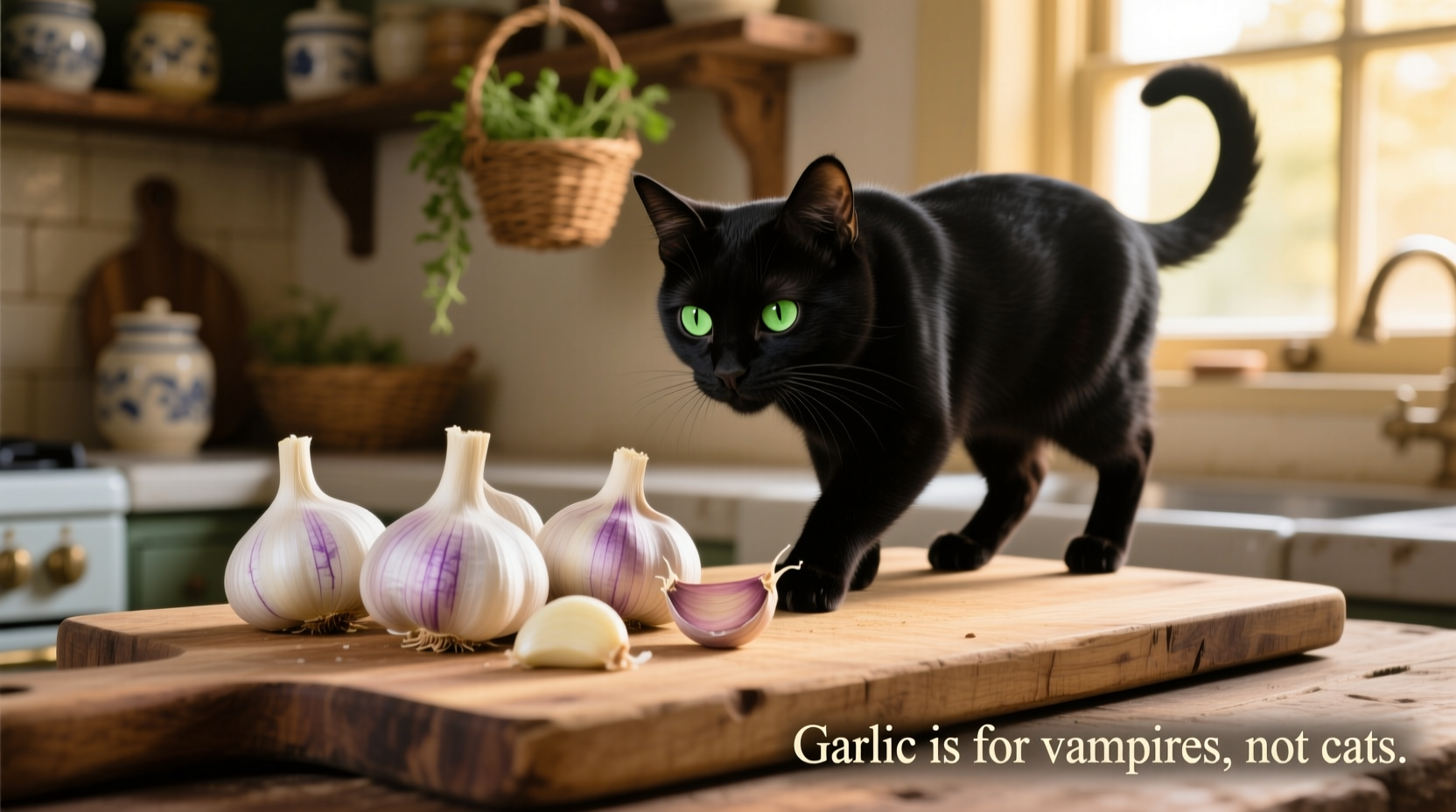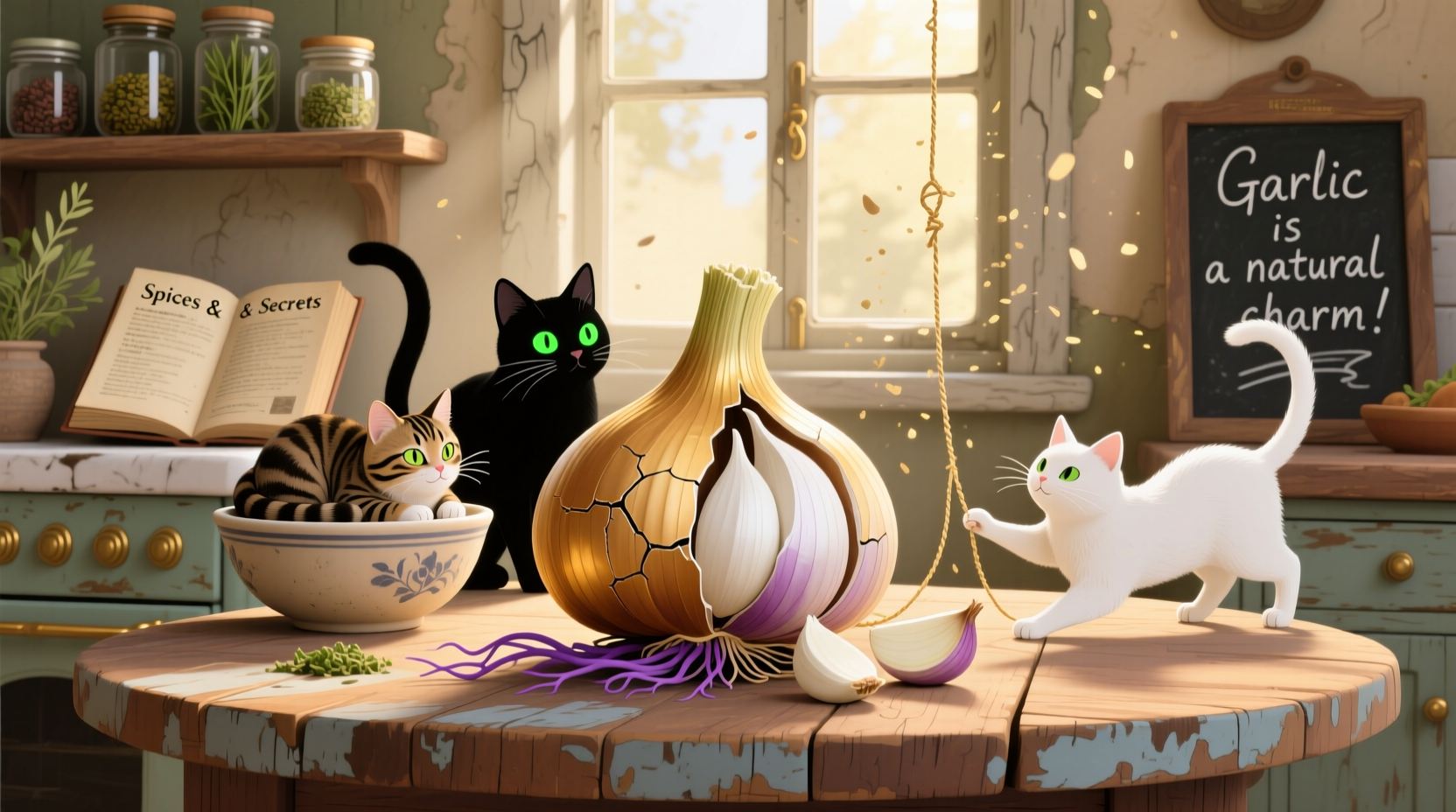Garlic is toxic to cats and should never be intentionally fed to them. Even small amounts can cause hemolytic anemia by damaging red blood cells, potentially leading to life-threatening conditions. Immediate veterinary care is required if your cat has consumed garlic.
As a culinary historian who's studied spice traditions across civilizations, I've seen how humans have incorporated garlic into countless dishes throughout history. But what works for us can be dangerous for our feline companions. Understanding the risks isn't just about avoiding obvious garlic dishes—many cat owners don't realize garlic appears in unexpected places like baby food, broths, and even some commercial pet treats marketed as "natural" flea prevention.
Why Garlic Poses Serious Risks to Cats
Cats lack the metabolic pathway to properly process compounds in the Allium family, which includes garlic, onions, leeks, and chives. When ingested, these plants trigger oxidative damage to red blood cells through a compound called N-propyl disulfide. This damage causes hemoglobin to form clumps called Heinz bodies, which the spleen then destroys—leading to hemolytic anemia.
According to the ASPCA Animal Poison Control Center, garlic is actually five times more toxic to cats than onions. While humans can safely consume these foods, cats' unique physiology makes them vulnerable to even trace amounts.
| Garlic Form | Amount Dangerous to Cats | Equivalent Human Consumption |
|---|---|---|
| Fresh garlic | 15-30g (1-2 cloves) | Less than 1/4 of what humans eat in garlic bread |
| Garlic powder | 5g (1 teaspoon) | Concentrated risk - powder is 6x more potent |
| Garlic oil | 2-3 drops | Used in "natural" flea remedies |
Symptoms Timeline: What to Watch For
Garlic toxicity doesn't produce immediate symptoms, which makes it particularly dangerous. The delayed reaction means owners might not connect their cat's illness with garlic exposure that occurred days earlier.
Based on research published in the Journal of the American Veterinary Medical Association, here's the typical progression:
- 12-24 hours: Gastrointestinal upset (vomiting, diarrhea, abdominal pain)
- 2-4 days: Pale gums, weakness, rapid breathing, increased heart rate
- 4-7 days: Dark urine (from hemoglobin breakdown), jaundice, collapse
"Many cat owners don't realize their pet has been exposed until severe symptoms appear," explains Dr. Tina Wismer, senior director at the ASPCA Animal Poison Control Center. "By then, significant red blood cell damage has already occurred."

Common Misconceptions About Garlic and Cats
Despite widespread misinformation online, there are no safe medicinal uses of garlic for cats. Let's address three dangerous myths:
Myth 1: "Small amounts of garlic prevent fleas"
Some holistic pet sites recommend garlic for flea control, but the Cornell Feline Health Center confirms there's no scientific evidence supporting this. The amount needed for any theoretical effect would already be toxic.
Myth 2: "Cooking destroys garlic's toxicity"
Heat doesn't eliminate the harmful compounds. In fact, cooked garlic in broths or gravies may be more dangerous because cats find these more palatable and might consume larger quantities.
Myth 3: "My cat ate garlic before with no issues"
Toxicity is cumulative. Previous small exposures may have caused subclinical damage that only becomes apparent after additional exposure. Cats with pre-existing conditions like kidney disease face even greater risks.
What to Do If Your Cat Consumes Garlic
Immediate action can save your cat's life. Follow these steps:
- Contact your veterinarian or animal poison control immediately—don't wait for symptoms. Have the ASPCA Animal Poison Control Center number (888-426-4435) saved in your phone.
- Bring the product packaging if your cat consumed commercial food or treats containing garlic.
- Do not induce vomiting unless specifically instructed by a professional—this can cause additional complications.
- Monitor closely for symptoms over the next 7 days, even if your cat seems fine initially.
Treatment typically involves intravenous fluids, oxygen therapy, and in severe cases, blood transfusions. Early intervention significantly improves outcomes—cats treated within 12 hours have much better prognosis.
Safe Alternatives for Cat Care
Instead of risky "natural" remedies, consider these veterinarian-approved approaches:
- Flea prevention: Prescription topical or oral medications (selamectin, fluralaner)
- Immune support: High-quality commercial cat food with balanced nutrients
- Dietary variety: Cat-safe herbs like catnip or valerian root for enrichment
Remember that cats are obligate carnivores with very different nutritional needs than humans. What enhances our meals could harm them.
Preventing Accidental Garlic Exposure
Protect your cat with these practical steps:
- Store human foods containing garlic out of reach—cats can jump on counters and open cabinets
- Check pet food labels carefully for garlic or onion derivatives (allium sativum, dehydrated garlic, garlic powder)
- Avoid using garlic-based essential oils in diffusers—cats groom themselves and ingest airborne particles
- Educate family members, especially children, about the dangers
- Be cautious with homemade pet treats—many online recipes contain unsafe ingredients
The Pet Poison Helpline reports a 30% increase in garlic-related cat poisonings during holiday seasons when families prepare large meals containing garlic. Stay vigilant during these high-risk times.
When Garlic Exposure Becomes an Emergency
Seek immediate veterinary care if your cat shows any of these critical symptoms:
- Difficulty breathing or rapid panting
- Complete lethargy or inability to stand
- Dark brown or red urine
- Gums that are pale, yellow, or brown
- Unresponsiveness
In these cases, every hour counts. Hemolytic anemia can progress rapidly, and delayed treatment increases the risk of permanent organ damage or death.











 浙公网安备
33010002000092号
浙公网安备
33010002000092号 浙B2-20120091-4
浙B2-20120091-4